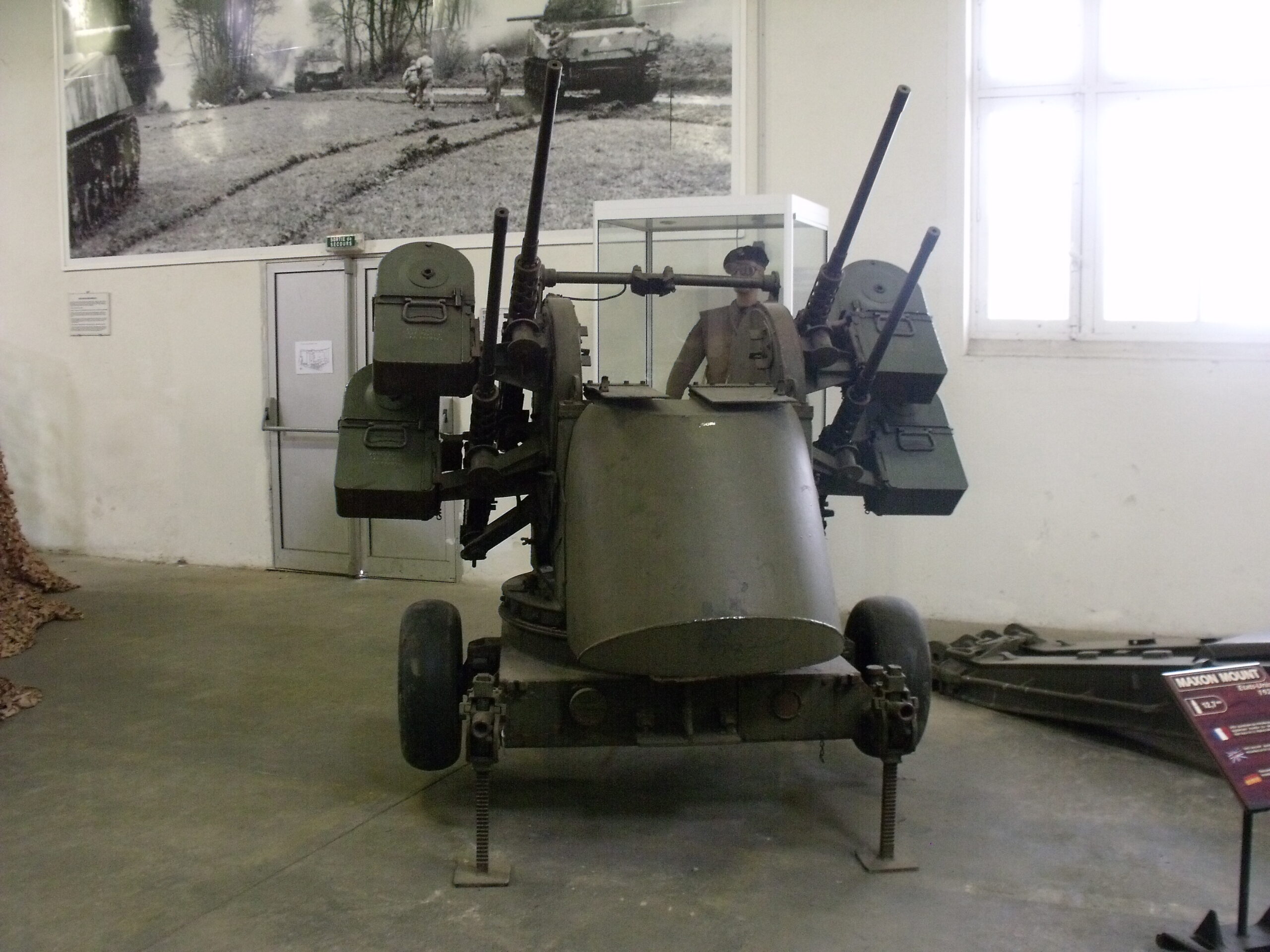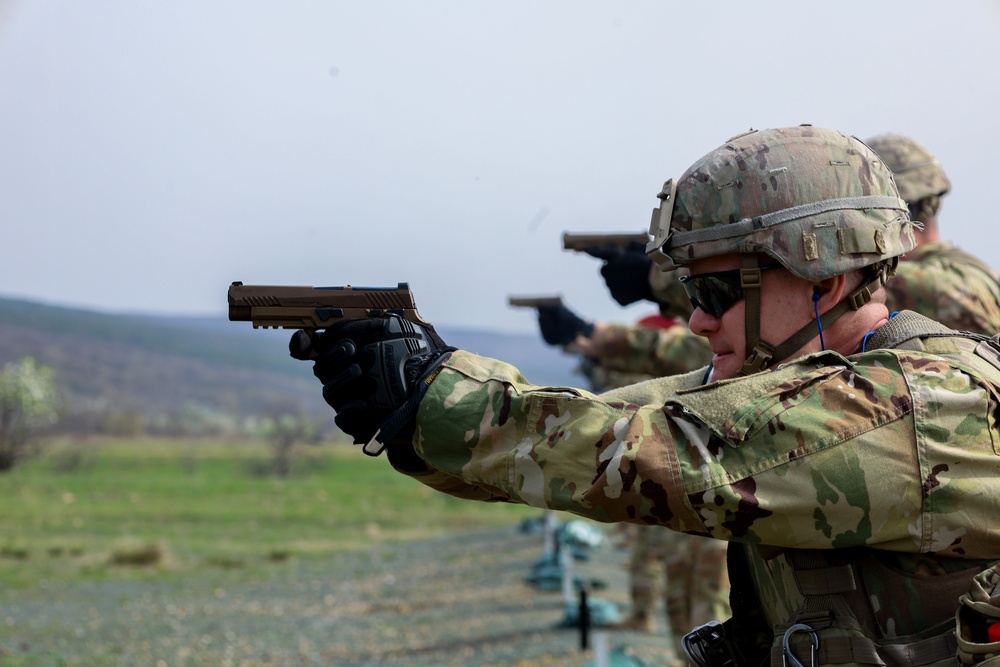The M45 Quadmount – The Krautmower weapon with the devastating power
- By Travis Pike
Share This Article

When I wrote my article on military weapon nicknames, I left the best out. I had never heard of the M45 Quadmount, and when I heard its name was the Krautmower, I was floored. When you’re fighting the Nazis, creative nicknames are a must, and it’s easy to see why the M45 Quadmount was called the Krautmower.
The M45 Quadmount was an American portable anti-aircraft weapon. As its name suggests, the Quadmount has four M2HD machine guns (also called Heavy Barrel version M2s) mounted on it. The guns were mounted on the top and bottom left and right corners of the Quadmount to create a deadly square. The M45 was designed for World War II but stuck around well into Vietnam.
The M45 Quadmount – Take it to the air

World War I might have introduced planes into warfare, but by World War II, they ruled the skies. Infantry, artillery, and armored forces were prey to the predators of the sky. With this in mind, a portable anti-aircraft weapon was absolutely necessary for ground warfare elements.
At the beginning of WWII, U.S. forces had the M33 twin mount, but two guns weren’t enough for this fast-moving war, so W.L. Maxson Corporation developed the M45 Quadmount.
The Quadmount had an electrically powered turret system and its turret was powered by a pair of rechargeable six-volt batteries. Its turret is capable of swinging in 360 degrees and could change elevation from -10 to +90 degrees. While the gun was designed for anti-air combat, it could be aimed at ground level if needed.
The mount was used on a trailer and carried ready through the open roads and fields of Europe. It granted immediate protection to Allied forces from air strafes.
Related: The Tankette – The most adorable tank ever created
Blasting away
The Krautmower’s operator sat in the middle with the guns oriented to the shooter’s sides. The system required two A-gunners to keep the weapon loaded and firing. Each gun carried a 200-round ammunition chest. The shooter can fire all four guns at one time, but in practice, the shooter fired two at once and switched between pairs of guns to conserve ammunition. This also allowed the barrels to cool and the shooter to reload and correct any malfunctions.
The M45 Quadmount could have the barrels converged to one point of aim at multiple distances, and the shooter could then reset the barrels and their convergence from the firing seat. It had an effective firing range of 1.6 miles and its M2HD machine guns could rip through the light designs of the planes of the era.
It also offered way more ammunition than cannon-type designs that used 20mm rounds, and while the Krautmower wasn’t as effective, it was more forgiving to the average operator.
Related: This bent-barrel rifle was one of Nazi Germany’s most weird weapons
Did it work?

The M45 saw plenty of action in the European theatre. It became an effective anti-air defense that was often located with ground warfare units. Armored units, artillery, and more relied on these guns to lay down the hate on German planes and could even intercept Messerschmitt fighter bombers. Allies often had air superiority, but the Messerschmitt could swing in, attack at a low altitude, and disappear before Allied fighters showed up. The Krautmower helped tackled these German planes.
One noteworthy use of the M45s was at the Battle of the Bulge. The anti-aircraft weapons were used against German infantry forces and provided what likely amounted to an extremely effective amount of supporting fire. It’s tough to move your infantry when a .50 cal is hitting them with ease a half mile away. It gained the nickname Krautmower after the battle.
The M45s also shined as the Allies were crossing the Rhine River into Germany. Germany sent 248 fighters to destroy the bridge and stop the Allies’ advance. M45 Quadmounts were responsible for 30% of the German aircraft casualties. The bridge stood, allowing the U.S. Third Army to invade Germany.
Related: The special operations that paved the way for D-Day
After World War II

The M45 didn’t disappear when the Nazis got put into the dirt. Instead, it stuck around through Korea and into Vietnam. In Vietnam, M45 Quadmounts found their way onto gun trucks to protect convoys from incoming North Vietnamese planes. By that point, planes were much faster, so Quadmounts relied on their overwhelming amount of firepower, which is one of the keys to surviving an ambush. With 800 rounds of .50 BMG, these guns were hell on wheels.
After Vietnam, the Krautmover faded away. Air threats became much faster, so they were handled by much bigger and more complicated weapons, and, as an infantry weapon, the M45 just wasn’t needed anymore. However, we shouldn’t be sad that Krautmower is gone: We should be happy it ever existed.
Read more from Sandboxx News
- US sends F-22s to Middle East to deter aggressive Russian pilots
- America’s massive military advantage nobody talks about: 500+ Refueling Aircraft
- Morgan’s Riflemen – The difference a small elite unit makes
- Everything you need to know about the US Army’s birthday
- US Marines reveal their rules for the Robot Wars
Related Posts
Sandboxx News Merch
-

‘AirPower’ Classic Hoodie
$46.00 – $48.00 Select options This product has multiple variants. The options may be chosen on the product page -

‘Sandboxx News’ Trucker Cap
$27.00 Select options This product has multiple variants. The options may be chosen on the product page -

F-35 ‘Lightning’ Framed Poster
$45.00 – $111.00 Select options This product has multiple variants. The options may be chosen on the product page

Travis Pike
Travis Pike is a former Marine Machine gunner who served with 2nd Bn 2nd Marines for 5 years. He deployed in 2009 to Afghanistan and again in 2011 with the 22nd MEU(SOC) during a record-setting 11 months at sea. He’s trained with the Romanian Army, the Spanish Marines, the Emirate Marines, and the Afghan National Army. He serves as an NRA certified pistol instructor and teaches concealed carry classes.
Related to: Gear & Tech, Military History

The HK MK23 built for SOCOM was the first and last offensive handgun

The slick custom shotgun carried by a Navy SEAL point man in Vietnam

Are the Army’s old Beretta M9 and new SIG M17 pistols as similar as people think?

The Switchblade, loitering munitions, and the new terrifying face of warfare
Sandboxx News
-

‘Sandboxx News’ Trucker Cap
$27.00 Select options This product has multiple variants. The options may be chosen on the product page -

‘AirPower’ Classic Hoodie
$46.00 – $48.00 Select options This product has multiple variants. The options may be chosen on the product page -

‘AirPower’ Golf Rope Hat
$31.00 Select options This product has multiple variants. The options may be chosen on the product page -

‘Sandboxx News’ Dad Hat
$27.00 Select options This product has multiple variants. The options may be chosen on the product page
